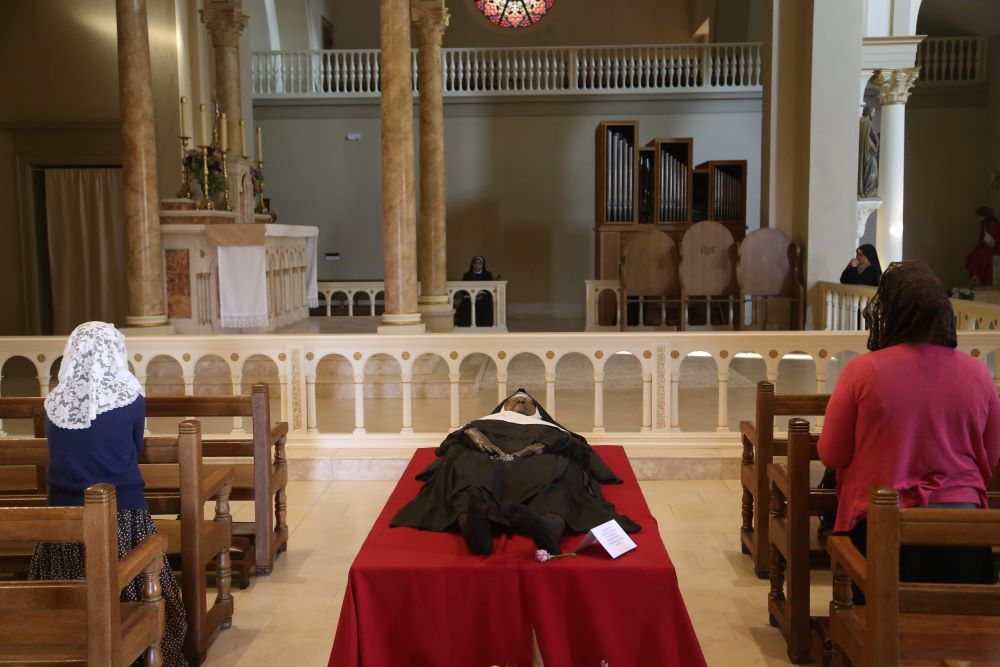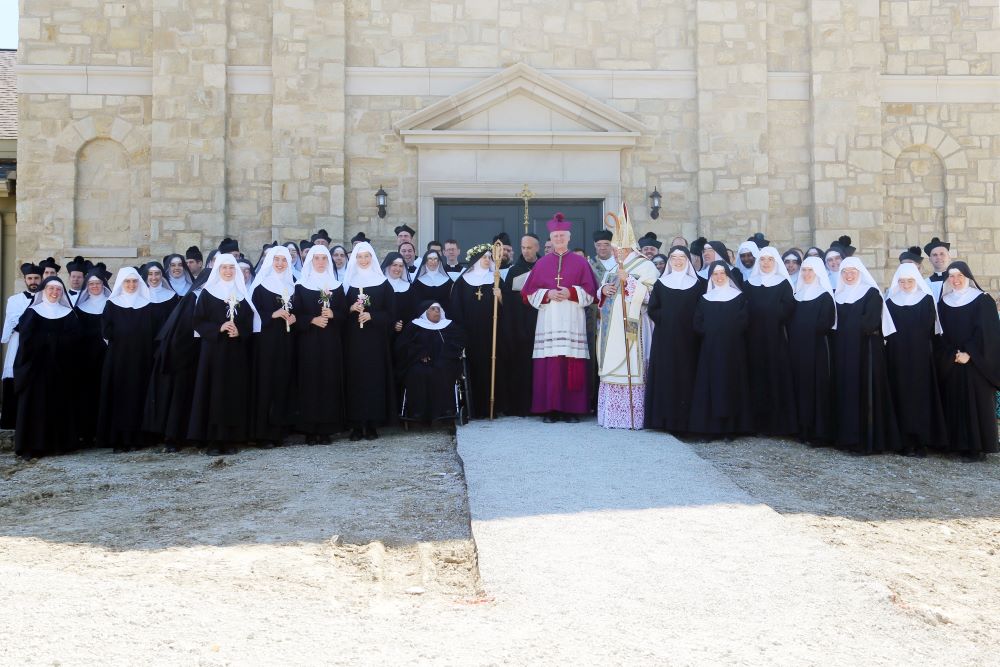
The exhumed body of Sr. Mary Wilhelmina Lancaster, foundress of the Benedictines of Mary, Queen of Apostles, lies in repose in the church at the Abbey of Our Lady of Ephesus in Gower, Mo., May 21. (OSV News photo/Megan Marley)
Sr. Wilhelmina Lancaster of the Most Holy Rosary claimed to have had profound religious experiences, beginning in her childhood. She was born Mary Elizabeth Lancaster April 13, 1924, in St. Louis. Her great-grandmother, Mary Madden, had been a slave.
During an April 28 exhumation, the body of Lancaster — foundress of the Benedictine Sisters of Mary, Queen of the Apostles, in Gower, Missouri — was shown to be little changed since her May 2019 death at age 95.
Ahead of Memorial Day weekend, Lancaster's community of contemplative Benedictine sisters in rural Missouri were preparing for as many as 10,000 pilgrims to flock to their monastery to view and pray before the body of their foundress. The discovery of the Black American nun's apparently incorrupt remains highlights the rich heritage of Black Catholics in the U.S., experts told OSV News.
In a short autobiography discovered after Lancaster's death, she wrote that at her first Communion in 1934, 9-year-old Mary Elizabeth had "an unforgettable experience," where "Our Lord asked me if I would be His." "He seemed to be such a handsome and wonderful Man. I agreed immediately. Then He told me to meet Him every Sunday at Holy Communion. I said nothing about this conversation to anyone, believing that everyone that went to Holy Communion heard Our Lord talk to them."
Notes with her eight-page autobiographical sketch, as shared by her religious community, also mentioned that the future Sister Wilhelmina also had a vision of the Virgin Mary, who thanked her for praying the rosary.

All the sisters of the Benedictines of Mary, Queen of Apostles, order stand with attending priests and deacons after the consecration of Abbess Cecelia Snell Sept. 10, 2018, at the Abbey of Our Lady of Ephesus in Gower, Mo. In the center, from left to right, are Sister Wilhelmina Lancaster, the order's foundress; Abbess Snell; Abbot Phillip Anderson of Our Lady of Clear Creek Benedictine Abbey in Hulbert, Okla.; Bishop James V. Johnston Jr. of Kansas City-St. Joseph, Mo.; and Bishop Robert G. Morlino of Madison, Wis. (OSV News/Catholic Key/Megan Marley)
On April 28, her body was exhumed from her grave to move it to a tomb in the monastery's chapel. Despite her body not being embalmed, damage to her wooden coffin, and water sitting on her grave — all elements that should have contributed to her body's decomposition — her body was found remarkably intact, the community's sisters say.
Except for a layer of dirt and mold, both body and religious habit were intact — despite a lack of embalming, an in-ground burial in a wooden coffin, and "a puddle of water" on the grave, the religious community said in an informational handout provided at its abbey.
Incorruptibility has long been regarded as a divine sign of sanctity in both Catholic and Orthodox tradition, and the bodies of more than 100 canonized saints have been seemingly untouched by decay.
The sisters said that a sainthood cause for Sister Wilhelmina may be taken up should widespread devotion to their foundress first be established.
When Sister Wilhelmina was 13, her weekly confessor asked if she had considered religious life. "I had not of course, but he thought I could be a good Sister," she wrote. She wrote to the superior of the Oblate Sisters of Providence in Baltimore, a historically African American religious community whose foundress, Mother Mary Elizabeth Lange, has since been declared a Servant of God and is on the path to sainthood. The superior responded, telling her to wait until she had finished high school before she joined.
Although their daughter had attended public schools through eighth grade, Mary Elizabeth's parents wanted her to attend a Catholic high school, so they founded "St. Joseph Catholic High School for Negros," "which lasted until Archbishop (Joseph E.) Ritter put an end to segregation of Negros in the Diocese," she wrote.
"I sort of put the idea of becoming a Sister on the back burner and applied myself to learning as much as I could about everything there was to learn," Sister Wilhelmina wrote. "Unfortunately, my parents spoiled me and let me sit down much too much to books and papers when I should have been up cooking, sewing and doing household work." Even as a child she kept a notebook of poems and rhymes, and she aspired to become a fiction writer along the lines of Louisa May Alcott, author of Little Women.
Despite those aspirations, on the day of her high school graduation, Sister Wilhelmina told two Oblate Sisters of Providence who were present that she wanted to join them, and that September, the 17-year-old left St. Louis for Baltimore. "I knew that the novitiate was a time of trial during which the community would look me over and decide whether I had a vocation to it or not," she wrote, "That September day however, when I entered the novitiate chapel for the first time, that same Lord who spoke to me in my First Communion welcomed me lovingly, put His arms around me and promised that from then on I would be His."
Sister Wilhelmina took first vows in 1944 and later taught in Catholic schools, although she didn't especially enjoy teaching. She earned her college degree in 1966. "During the 22 years between 1944 and 1966 I had a short, happy stint at housework — mainly cleaning — at St. Rita's Residence in St. Louis and then at St. Frances Home for Girls where I learned that children had worries and broken hearts," she wrote.
In 1972, Sister Wilhelmina left teaching for good after "disciplining a student who complained," she said. She returned to the Oblates' motherhouse and began working on a history for the order, but she felt "despondent" about her failures, including in teaching. She was inspired at that time to write a poem honoring Jesus in the Eucharist, which another sister later put to music.
Meanwhile, she was dismayed by changes the Oblates were making, including to their habits, she wrote. While she adopted a modernized habit for three years, she returned to the order's traditional habit in 1974.
"I had no thought or desire of leaving my community in those days, but I was gung-ho for seeing it reformed," she wrote. "We had made a wrong turn, I said, and should go back. The rule of silence and monthly chapter (meeting) were long gone." She began to advocate for her community to begin a contemplative branch, but to no avail.
In the early 1990s, Sister Wilhelmina connected with priests of the Priestly Fraternity of St. Peter, a community of priests known for celebrating the Mass in Latin and using liturgical texts promulgated before the Second Vatican Council, who had begun ministering in Scranton, Ohio. With their help, she established a new religious community affiliated with the Fraternity priests in 1995, ultimately breaking ties with the Oblates in 1998.
Advertisement
"It would seem I did a very foolish thing," she said of founding the new community. "To those who say that my leaving my old community to found a new one didn't make sense, I reply that it is understandable only in the life of faith. … If there's anything I would want to pass on to the community, it would be: Devotion to Our Blessed Mother, True Devotion to Our Blessed Mother."
In 2006, the community moved from Scranton to a rural area in the Diocese of Kansas City-St. Joseph in 2006 at the invitation of Bishop Robert W. Finn, changing its name to the Benedictines of Mary, Queen of Apostles. Originally established as a public association of the faithful, the community was elevated in 2014 to the status of Religious Institute of Diocesan Right.
In 2018, the community's priory gained official recognition as an abbey. The following year, the community established its first daughter house in Ava, Missouri. The sisters worship in Latin using the form of the Mass promulgated prior to the Second Vatican Council and chant the psalms using the 1962 Monastic Office.






